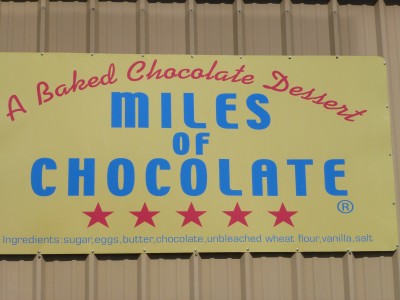
by Food+City | Apr 25, 2012 | Food Tracks Blog, Stories
“No cakey-ass brownies here,” declares Miles Compton about his baked chocolate dessert. In a food culture that insists on knowing the farmer who grows its corn and the exact percentage of butterfat in a cookie, how is it that Miles is so successful with his somehow unknowable chocolate dessert?
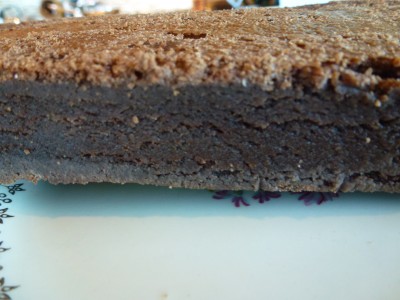
Long-time Austin food columnist, the late Katie Crider said that Mile’s dessert is “anything you want it to be.” And she was right. Virginia Wood, another Austin food writer said the dessert was “a cross between a brownie and a melt-in-your-mouth chocolate truffle. And she was also right. Unable to endure the suspense, I followed Miles’ directions, ate his chocolate dessert cold, and found it almost fudgy, full of intense quality dark chocolate, and was surprised that the top crust could retain such a light, crisp texture. I was beginning to see why his customers come back for seconds.
For sale in Whole Foods or Central Market in Texas, his chocolate dessert looks like a brownie. But it’s not. But it’s also not a gooey fudge-like cake. Sitting in its clear plastic store container, Miles’ dessert begs for answers. Why does this mysterious dessert have such a loyal following in a food culture that expects to know the ingredients of everything else?
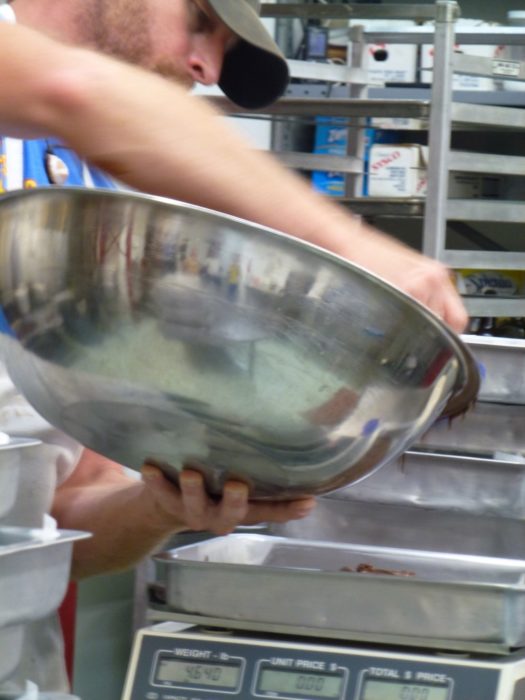
Miles is good at creating the mystique that follows his desserts to the table. No amount of subterfuge will divulge the source of his chocolate or his recipe. His website flaunts his main ingredients, butter, eggs, chocolate. But that’s all. Nothing about local eggs, exotic Valharona chocolate, or hand-made butter. His customers apparently give him a pass, consuming hundreds of pounds of Miles of Chocolate, as it’s called, over the past decades.
Miles of Chocolate, made by Miles, an ex-Marine, has what marketers call “stickiness.” Not to be confused with how his chocolate creation can feel in your hands, the stickiness of his dessert is more about how his customers remain loyal as culinary trends change and warning from health officials about the detrimental effects of eating butter. In his book, The Tipping Point, Malcom Gladwell points out that some products will survive because of a particular quality. Miles has found the sweet spot that causes his customers to remain stuck on his desserts, in spite of his mysterious recipe and unimaginative packaging.
These nine-by-thirteen rectangles of chocolateness could be mistaken for large brownies. Brownies, so called because of their color (originally from molasses in the early recipes), made their appearance in the 1897 publication of the Sears Roebuck Catalog but were also consumed at the 1893 Columbian Exhibition in Chicago. Somehow, Miles has transformed this enduring confection into “crack disguised as the best brownie you’ve ever had,” as one Yelp review exclaimed.
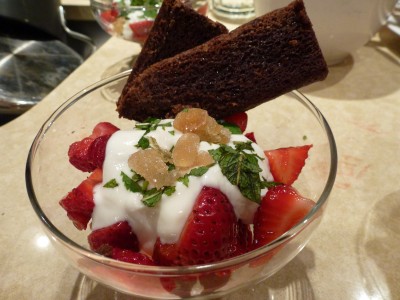
Two people run Miles of Chocolate, Miles and his business partner Ben, both in business for about eight years. Over two decades ago, Miles’ hairdresser/astrologist consulted the stars and announced that Miles should be a chef. Beginning as a dishwasher, Miles began baking after several years as a chef, working in Corpus Christi and then Austin. He soon discovered and tweaked his chocolate dessert recipe, now the star attraction of his business. Five stars glow from his logo, a self-assured declaration familiar to restaurant reviewers.
Not content to rest on his laurels as a recipient of the Austin Chronicle’s award for the best local chocolate for four years running, Miles fits into Austin’s food scene by displaying a familiar creative resistance and nonconformity the local culture. By refusing to admit his dessert is a brownie and concocting it with unimaginable amounts of eggs and butter, he plays to Austin’s creative audacity, the same audacity that evoked the “cakey-ass” comment. And there’s plenty of evidence that he knows what he’s doing: his customers eat up his culinary attitude, coming back year after year. Thank the stars for Miles of Chocolate.
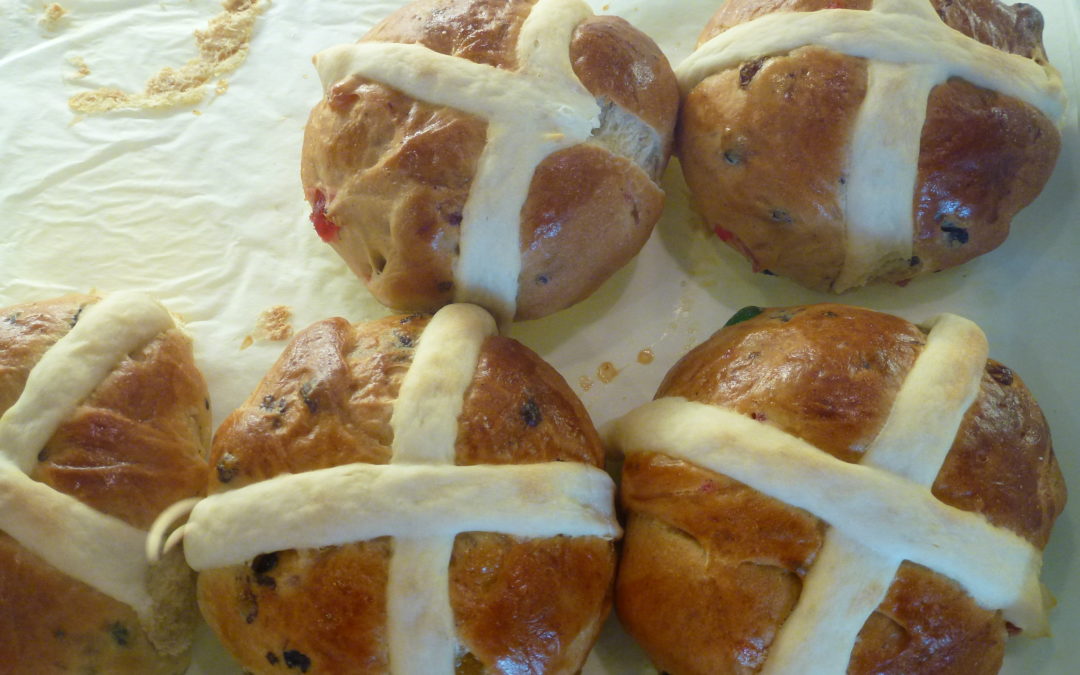
by Food+City | Apr 17, 2012 | Food Tracks Blog, Stories
While pondering the nature of our food system, I find parts of it in places that seem unrelated, at first. A bakery in Austin may seem connected to the system through the production of bread, the loaves and croissants traveling from the baker’s commercial kitchen into the hands and mouths of hungry Austinians every morning. But the system engages other less apparent components of the system, like dairy companies, flour manufacturers, and truck drivers. A recent visit to the bakery shed light on how these other companies contribute to the crusty loaves from one small bakeshop.
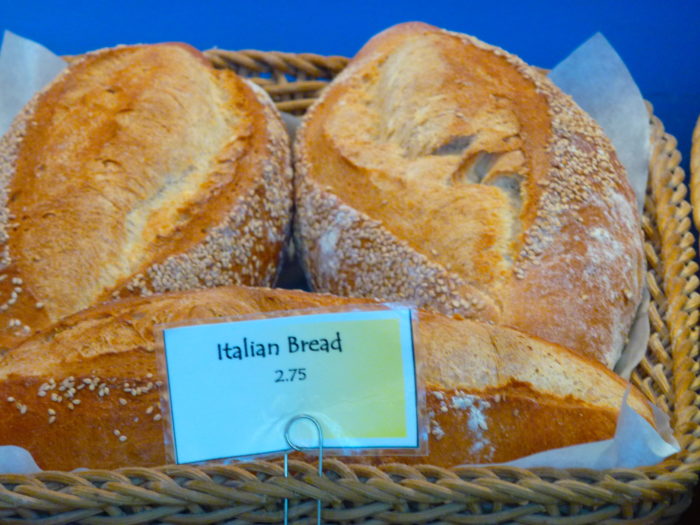
Derek Stilson, owner of Moonlight Bakery in Austin, Texas has been observing the moonlight for decades. A graduate from the University of Texas in Linguistics, he picked Moonlight for the name of his bakery with an eye towards descriptive meanings of words, connecting the moon, light, moonrise, and bread rising. Derek comes to bread through years of training, first as Whole Foods first in-house baker, then through stints at local Austin restaurants and bakeries before attending the American Institute of Baking in Kansas and teaching culinary arts at an Austin high school for eight years. Since 2003, he and his wife, Norma, owned the Moonlight Bakery, a small bakery that produces classic breads and pastries.
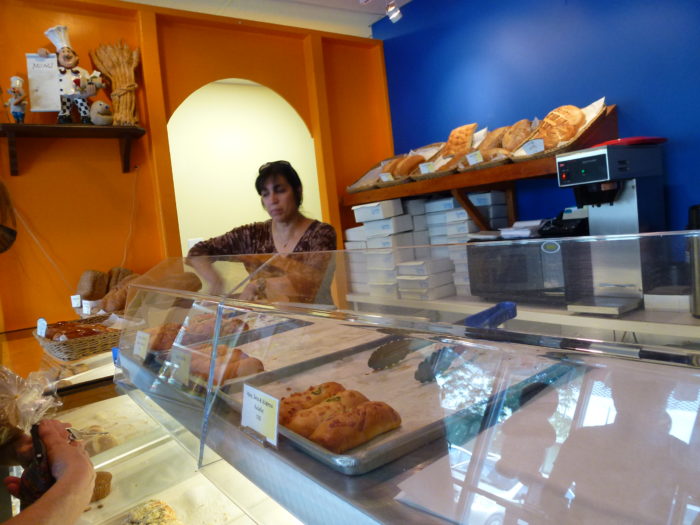
While bakers adopt adjectives like “artisanal,” Derek simply bakes well-known and well-loved breads and pastries. During the week preceding Easter this year, his bakery case was bulging with Hot Cross buns, classic Easter treats, emblazoned with sugary crosses. The baked apple fritters revealed chunks of apples and cinnamon rolls could hardly contain the ribbons of melted sugar and spice within their creases. All sorts of classic breads filled the wicker baskets: whole wheat, multi-grain, Italian, sourdough, and focaccia breads and rye loaves. The ciabatta was perfect, a hard outside crust around a soft, chewy interior that filled the room with the aroma of caramel when toasted. It’s the kind of ciabatta that enveloped huge wells of butter and jam in pockets created by yeasty bubbles. A new restaurant, The Hillside Farmacy, in East Austin uses Moonlight ciabatta for a mushroom, caramelized onion, Brie sandwich.
Understandably, a visitor to the bakery could become transfixed by the scrumptious goods in the pastry case; but other sights in the small shop reveal other stories implicit in the provisioning of Austin with Derek’s admirable loaves. Piled high to one side, on pallets, were bags of flour awaiting entry to the back of the shop where the flour became bread. Two suppliers’ names identified the source of the bags: King Arthur Flour and Johnson Bros. Bakery Supply. Both purveyors provide histories that add texture to the bread supply chain. They also represent those many other players in the food system that are often over looked in the provision of some of our very basic food products. For the Stilsons, flour and baking pans are the bread and butter of their business.
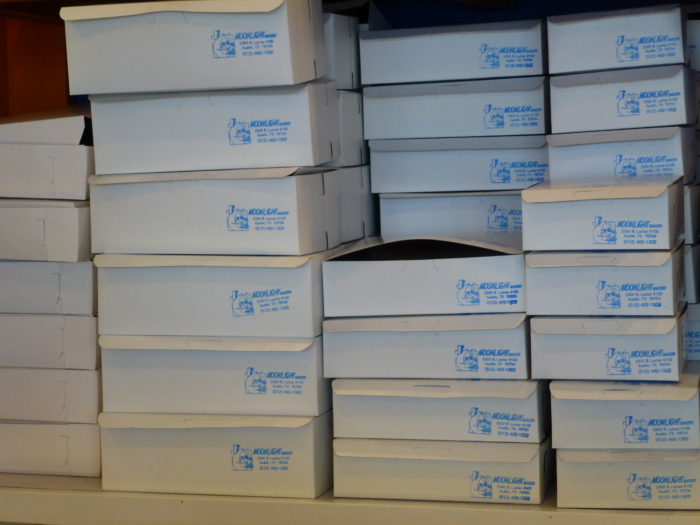
King Arthur Flour is the oldest flour company in the U.S. Founded in Boston, Massachusetts 1790 by Henry Wood, the company sold flour imported from England and unloaded from British ships as they docked in Boston. The company began milling its own flour and by the 1890s announced its American-grown flour at the Boston Food Fair. Now, after 222 years, King Arthur flour operates from its corporate headquarters in Vermont, ideally suited to the state’s culture of culinary traditions. You can buy industrial bags of flour, like Moonlight Bakery does, or peruse American-made cookie sheets in King Arthur’s catalog. Moonlight, old-school with its line of classic baked goods, seems perfectly aligned with its source of flour from a company named after classic myths with deep historical ties to New England.
Johnson Bros. Bakery Supply Inc. lacks the long historical roots of King Arthur Flour but instead comes to Moonlight with connections to Texas history. Founded in 1994, a mere eighteen years ago, the company headquarters is in Houston. Two brothers raised by parents who ran bakeries in Minnesota and Texas, learned their trade by making doughnuts and decorating cakes. In the 1990s, they formed a company to supply the bakers, including the flour that sits in the front of Moonlight’s bakery shop. Twenty trucks deliver bakery supplies in Texas, operating in Texas and Oklahoma. The two brothers, Kevin and Blaine sell all kinds of bakery supplies, from flour to icing to chocolate for cake fillings.
These bags of flour, some from Vermont, some from Texas, convey an all-purpose, no frills approach to the Stilson’s bakery. They also represent two of dozens of other suppliers that bring paper bags, butter, eggs, cash register paper tape, and light bulbs. They all go into the loaf that Norma and Derek bake. Seems like to appreciate and understand how our food system works, we need to cast a wider net, think more broadly while we think deeply about the food we eat. Our findings may lead us to a much broader landscape that includes surprising participants in the business of feeding urban populations. Cookie sheet manufacturers, the fuel required to transport the sheets, the packing materials, labor, and metals used to produce the sheets, combine in our food networks. One inspired baker in Austin is only one location on the long road traveled by a grain of wheat to the breakfast table. Unraveling this network could be one of the most interesting and revealing projects yet.
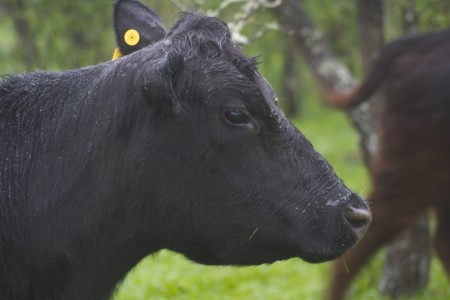
by Food+City | Apr 10, 2012 | Food Tracks Blog, Stories
Mary-Rose and Lefty Fisher’s farm, Rancho benedicion de Dios (translated Blessing of God Ranch), was awash in a much-needed rainstorm last week. Texan’s don’t mind the inconvenience of flooded streets when rain brings a break in the Texas drought. And on the day that I visited Mary-Rose in March, her pastures were green and the Black Angus cattle stood out, rivulets of water trickling down their big steamy bodies. As bovines are wont to do, they were ruminating after pulling at the green grass that would soon rebound after these spring rains.
But their black cattle were also looking afield, searching for their newborn calves, a common addition to their herd during March. Already this year they have five new calves, each cossetted behind thistles and other low-growing shrubs. The ranch raises about 20 cattle, all Black Angus. But these newborns represent a new initiative on the ranch. This year, the Fishers leased a Wagyu bull, a cattle breed, literally “Japanese cattle,” that has been associated with the Kobe region of Japan. Up to 25% of a Wagyu steak is unsaturated fat, marbled throughout the meat. The meat is extremely tender, flavorful, and possibly the “foie gras” of the beef world. By crossing the Wagyu bull with their Black Angus cattle, Mary-Rose and Lefty hope to produce an even more flavorful, tender meat product in the next few years.

Experimentation is nothing new for these ranchers who just started raising cattle in 2003. When the Fishers purchased their ranch, they had to reclaim the soil in preparation for organic certification. Today they produce organically raised grass finished cattle. Their Wagyu-Angus project along with their organic practices, make their ranch a small and carefully managed enterprise. Their customers, individuals and a local resort scoop up their beef products, evidence that they’re on to a good thing. Both Mary-Rose and her husband are reassuring evidence that new ranchers don’t require a long pedigree to enter these niche markets. Both are not native Texans and have come from other careers. By reaching out to other ranchers, reading, and observing how ranches operate, they have been able to begin a small and innovative beef ranch. The Rancho benedicion de Dios, may just be the model for a new breed of farmers that wants to innovate, stay small, while selling to a market that is willing to be patient, pay higher prices, and appreciate locally raised, organic meat, called by Fishers, “Holy Organic Beef™”
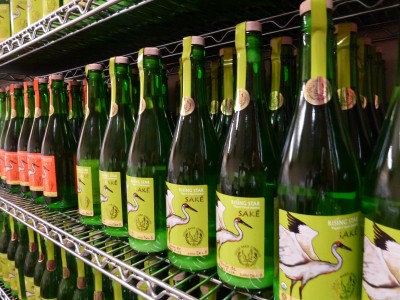
by Food+City | Apr 4, 2012 | Food Tracks Blog, Stories
Yoed Anis makes sake in Texas. Born in Israel, but a self-proclaimed Texan, Yoed began his enterprise, Texas Sake Company, in the fall of 2011, propelled by his love of brewing beer and an attraction to a natural connection between the historical tradition of rice growing in Texas and the potential of brewing sake. Immigrants such as Yoed and Texas rice, the medium-grain variety used to make sake, both have long histories in Texas foodways.
From the late 19th century, Texas has been growing rice, a crop increasingly threatened by the recent Texas drought. During the 1880s and ‘90s, several entrepreneurs and companies saw an opportunity to develop rice farming in Texas and Louisiana, where water was plentiful and land was cheap. A group of Texas entrepreneurs met in 1879 in Houston to build a railroad from New Orleans to Houston, connecting Louisiana, known for growing rice, with Texas. This extension of the transportation infrastructure brought immigrants from the Midwest and encouraged innovation. The railroad company promoted cheap land prices and better agricultural conditions for Midwestern wheat farmers who were suffering from a succession of crop failures and a drought. Encouraged by the railroad promoters, the farmers brought their knowledge of wheat crops to Louisiana where they bought land and learned how to grow rice from the Cajun community. Soon, the John Deere tractor company developed new equipment for rice farmers and the scientists at Texas A & M developed a new variety of rice, one that would not crack under the pressure created by new milling machines. The variety was a cross between long grain Cajun rice and a medium-grain Kyushu rice, a Japanese rice introduced by the Japanese who were hoping to find more land in Texas to expand its own rice growing capacity. The result was a medium-grained rice suited to the emerging rice industry in Southeastern Texas.
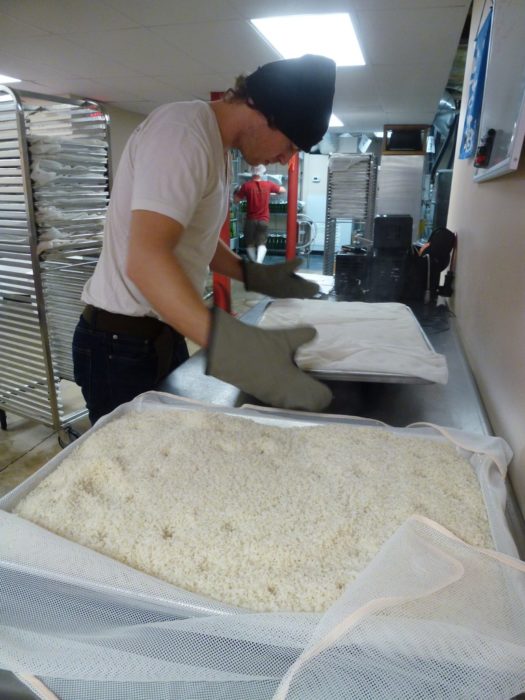
Soon the U.S. government joined these entrepreneurs and companies to support the growth of mills by adjusting freight rates to encourage entrepreneurs to build new rice mills. By the end of the 1890s, Texans joined the Louisiana rice farmers, led by entrepreneur Joe Broussard, who converted a grist mill and brought the tractors, canals, and rice to Beaumont, establishing a long tradition of rice growing in Southeast Texas, near ports where rice shipments could travel to other U.S. cities. By 1902, almost all the rice grown in the U.S. came from Texas and Louisiana.
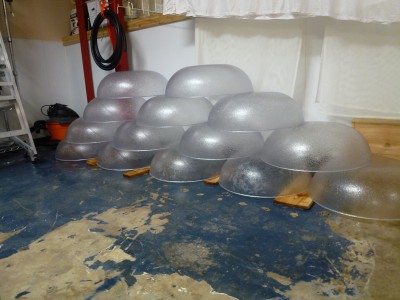
This makes Yoed part of a very long tradition that originated in the 19th century. He is adding his own innovation by introducing sake brewing into a thriving micro-beer brewing culture in Texas, particularly in Austin where microbreweries abound. Reaching out to what remains of the tenacious rice growing community, Yoed buys organic, medium-grain rice from two Texas farmers and brews sake in a small warehouse in North Austin. Texas Sake Company produces two varieties, Whooping Crane (a clear, clean tasting sake), and Rising Star (a Nigori sake, sweet, country-style). Yoed and his brewers hand wash the rice before beginning a long cold fermentation process that uses sake bacteria. The company only produces 500 hundred bottles at a time, each bottle portraying the Texas whooping crane, an inhabitant of the Colorado River, a source of water for Texas rice farmers. One can only hope that entrepreneurs such as Yoed might find ways to continue growing rice in Texas, even under drought conditions. New technologies might emerge that could adapt rice to dry climates. And innovative ways to use rice, such as sake brewing, might encourage at least some of the remaining rice growers in Southeastern Texas. According to Yoed, sake is a perfect compliment to Texas BBQ. He is not only leading a sake revival in Texas, but by making a connection between Texas rice farmers, sake and BBQ, he might find a way to the hearts and bars of appreciative Austinians.
by Food+City | Apr 2, 2012 | Food Tracks Blog, Stories
A few weeks ago, my family challenged me to become a vegan for a week. For an enthusiastic omnivore, a week of what I viewed as deprivation was indeed challenging. As the days passed, I moved from curiosity to resentment to anger and then finally, acceptance. Two unexpected epiphanies came out of this experience. The first was that veganism can feel single-dimensional, like listening to an a cappella group instead of a symphony orchestra. Without meat, or at least dairy products, vegan diets feel thin, their ingredients lacking the tonal capacity to play off of one another, relying on solo performances for a discriminating audience. The second surprise was that with a little imagination, life without animal products is tenable and can consist of flavorful, tasty meals. Maybe even healthier.
With this week behind me, I explored a local vegan bakery, The Happy Vegan Baker. Veganism appeared first in Britain as an offshoot of The Vegetarian Society founded in 1847. Some Britons found the non-carnivorous life still too promiscuous. Almost fifty years later, British social reformers, motivated by both evangelicalism and the Quakers, demanded more protection for children who were factory workers and animals. In the 1890s, Henry Salt founded The Humanitarian League to improve the welfare of humans and non-humans. Almost a hundred years later, a more radical group emerged (1944) that rejected the idea of eating any animal products at all, including those that did not require killing an animal, like butter and cheese. In some ways, the rise of veganism after WWI parallels the recent lurch to localism, the intention to eat locally grown food. Both movements, if considered a form of dietary activism, entail rejecting one practice for another and the drawing of boundaries between one “purer” morality than another.
These vegetarians and vegans were hardly the bohemian left of society. Many were conservatives, whose bold rejection of British meat-eating identity signaled a modern sensitivity and rejection of animal cruelty. Some vegetarians in the early 20th century saw the consumption of dairy and eggs as only a temporary expedient on the way to total rejection of animal products. It is no wonder that these were the first to form the first vegan group in Britain in the 1940s.
People draw these boundaries for both ethical and health reasons and emerge during good economic times when people have more disposable time and money to consider choices previously unavailable. Combined with a fashionable interest in Eastern philosophies, new economic freedom led to more discretionary diets, and more boundaries between eating communities. A recent article by Jessica Greenebaum in Food, Culture & Society argues that vegans engage in a process that is constantly negotiated and situational as they seek to become more authentic within their community.
Vegans are thriving in Austin’s community. Most restaurants and food trucks offer vegetarian options and more and more include a vegan dish. A website called VeganAustin.org is the home of a group called Vegans Rock Austin. The group bestows the rating of “Vegan Best of Austin” to local restaurants while it sponsors an annual event, the Texas VegFest where you can meditate, participate in a bodybuilding event, or watch cooks demonstrate how to make tasty vegan dishes. A combination of health and spiritual wellness infuse the vegan groups in Austin and one such enlightened vegan is Inge Jorgenson.
This is no happier vegan cook than Inge at the Happy Vegan Baker. The beaming baker is a graduate of Cordon Bleu and a lifelong vegan. She came to Austin from Cape Town, South Africa in 2009, began to work at Hudson’s On the Bend, the University of Texas at Austin and Lakeway Spa Resort until her baking business began to take off. Now, she combines her bakery business with her work as a dietitian at Seton Family of Hospitals, a fitting occupation for someone who is finicky about food.
Inge was always careful about what she ate, according to her parents, Charlotte and Andre. While not proselytizing veganism, Inge feels that vegan diets are generally more healthy than other diets. Her parents recently joined her in Austin to work together in the bakery. Charlotte, a former special education teacher, and Andre, who formerly worked in the armaments and cellular telephone industries, both bring a home-cooked feel to the bakery menu and management skills for the business side of the business. Now there are three smiling vegans in the kitchen, an auspicious combination for a company that is expanding its business and growing its capabilities. And far from separating vegans from omnivores, Inge is doing her best to embrace all food lovers by baking pastries and concocting new recipes that appeal to the palates of anyone who appreciates tasteful, fresh, and imaginative food.
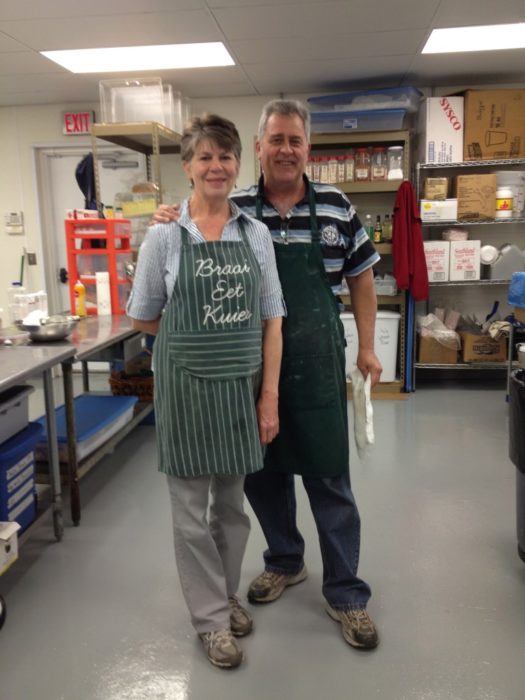
The Happy Vegan Baker is a family affair and their affection for each other is evident. Their kitchen, or commissary, as Inge calls it, is hidden behind other small confectionary enterprises in a unremarkable office park, absent a sign or directions to the bustling bakery. But inside its brightly lit space, mixers are humming and smells of pureed fruit fillings and dark chocolate cake batter fill the atmosphere. The bakery produces small fruit-filled tartlets, cakes, pies, cupcakes and is now venturing into more savory affairs, like breakfast tacos. Surprising to some of us non-vegans, is that these confections taste good. While missing the usual eggs and butter omnipresent in traditional pastry, Inge’s creations use vegetable shortening and innovative combinations of ingredients to produce tastes and textures that are satisfying and perfectly acceptable, even to us non-vegans. Billowy clouds of icing hover atop dainty cupcakes that fill Inge’s stall at the local farmer’s markets. Her business began in 2007 when she first got her space at one of Austin’s farmers markets. From there, she and now her family have expanded to other markets. One day they hope to open their own small café with a warm, home-like feeling, an aspiration that seems well within reach of Inge and her this dedicated family. A long cry from the seriousness of the original vegan movement in Britain, Inge’s happy countenance is reason enough to partake of her pastries. And her apple tarts, which I recently enjoyed, contributed to the revised view I now hold about vegan diets. Political and social implications aside, veganism plays an important part in our culinary landscape and offers choices and opportunities for innovation. Inge is one of those innovators who seems to be re-inventing vegan cuisine in ways that are appealing to even the avid omnivore.
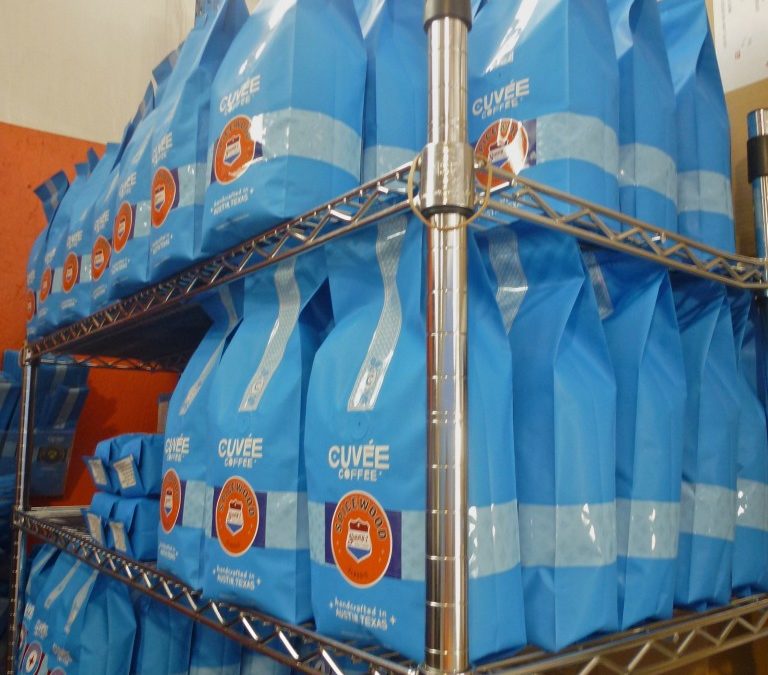
by Food+City | Feb 27, 2012 | Food Tracks Blog, Stories
To encounter Clancy Rose, Cuvee’s coffee roaster, aside one of his burnished Samiac machine is like meeting the owner of a Ferrari or Maserati. Words like “first crack” and “carmelization” tumble into the room, creating a continuous riff of geeky adjectives familiar to aficionados of high tech and high design. Clancy is one of five employees at a small Austin roaster, one that telegraphs technology in so many ways, not to mention in Clancy’s language and style. He relies on the shiny stainless steel digital controllers athwart each roaster that tweak and time the machines, enabling Cuvee to roast the best beans consistently, predictably, and according to specifications developed since its founding in 1998.
Cuvee’s name comes from the term reserved for wine, a description for the highest quality grapes used the production of sparkling wine or champagne. The founders like to think of their business as similar to the wine business, seeking beans like reserves of grapes, roasting instead of fermenting, speaking in terms familiar to wine sommeliers when describing their beans to customers. The company spends a lot of time with its farmers in order to develop beans and roasts in much the same way as wine makers work with soils, climates, and grape varieties. Beans are an obsession to these coffee geeks.
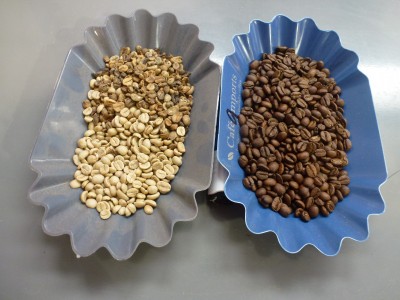
Founders Rashelle and Mike McKim were early pioneers of the direct trade movement, a role that led them to work directly with farming communities in the countries where they purchase coffee beans. And the company’s affinity for technology began long before the founding of Cuvee. Mike’s uncle, Carl Staub is a food scientist who invented a technology for measuring the degree of roast. A machine called a spectrophotometer from Carl’s company, Agtron, supplies Clancy’s competitive edge, allowing him to nudge the beans towards a roast that he and his team believe draw out the best qualities of each bean from each harvest.
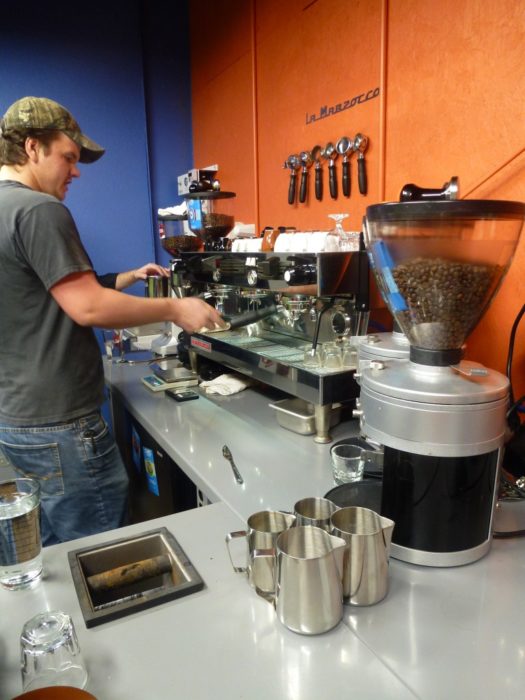
Mike started Cuvee after a job installing fiber optic cables, transforming his personal network away from digital geeks to roasting geeks. He and a friend started to experiment with coffee beans when they purchased a Samiac machine designed for professional roasters. They turned out large batches roasted beans, enough for them to supply their growing circle of fans. They moved from hobby roasters to professional roasters, following the growth of coffee culture from Seattle to Portland, from Starbucks to Stumptown, as they used the Agtron technology to roast predictably and often.

The company headquarters is in Spicewood and operates in a low-profile, unmarked building common in the world of low profile high technology companies. The tasting room has the feel of a Maseratishow room, but instead holds equipment from La Marzocco an Italian espresso machine manufacturer. Polished steel and glass brighten the room full of small cups, dark beans and tiny spoons perched aside single shot glasses.
Cuvee’s roasters inhabit a large warehouse, with the owner’s speedboat at one end and pallets of beans at the other. In the middle are whirring machines that consume bucket loads of green beans into their heated cavities, each with a small glass window that reveals the beans as they turn slowly from light green to varying shades of brown. Cuvee’s trademark blue bags pile up on shelves, each marked with labels intensely designed with the logo of a customer or images that connote a particular coffee region, location or personality of their own Cuvee culture. One bag, marked Spicewood, contains beans that are Cuvee’s houseblend, named after the company’s hometown. Another Fazenda Pantano is for the Brazilian family Ferrero that produces a chocolaty, nutty, smooth bean using a method called “honey processing,” which Cuvee says gives the beans a “clean” taste. Does this remind you of wine tasting terminology?
Cuvee sells mostly to independent coffee shops such as Caffé Medici and Once Over Coffee, but its blue bags also appear in grocery shops such as Whole Foods Markets and restaurants such as La Condesa and Barley Swine. You can bet that the Agtron will be put to the test as Mike reaches his revenue goal of $12 million in five years. Those robin’s egg blue bags may become an Austin symbol far outside the city limits.


















